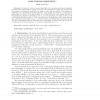Free Online Productivity Tools
i2Speak
i2Symbol
i2OCR
iTex2Img
iWeb2Print
iWeb2Shot
i2Type
iPdf2Split
iPdf2Merge
i2Bopomofo
i2Arabic
i2Style
i2Image
i2PDF
iLatex2Rtf
Sci2ools
CORR
2007
Springer
2007
Springer
Matroid Pathwidth and Code Trellis Complexity
We relate the notion of matroid pathwidth to the minimum trellis state-complexity (which we term trellis-width) of a linear code, and to the pathwidth of a graph. By reducing from the problem of computing the pathwidth of a graph, we show that the problem of determining the pathwidth of a representable matroid is NP-hard. Consequently, the problem of computing the trellis-width of a linear code is also NP-hard. For a finite field F, we also consider the class of F-representable matroids of pathwidth at most w, and correspondingly, the family of linear codes over F with trellis-width at most w. These are easily seen to be minor-closed. Since these matroids (and codes) have branchwidth at most w, a result of Geelen and Whittle shows that such matroids (and the corresponding codes) are characterized by finitely many excluded minors. We provide the complete list of excluded minors for w = 1, and give a partial list for w = 2. Key words. Matroids, pathwidth, linear codes, trellis complex...
CORR 2007 | Education | Linear Codes | Matroids | Pathwidth |
| Added | 13 Dec 2010 |
| Updated | 13 Dec 2010 |
| Type | Journal |
| Year | 2007 |
| Where | CORR |
| Authors | Navin Kashyap |
Comments (0)

